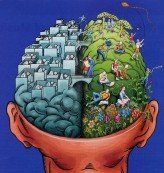|
Inspirational MotivationHow To Inspire Your People in Tough Times
How do you provide inspirational motivation to people living with the constant insecurities engendered by the current economic climate? How do you deal with downsized workforces populated with employees who suffer from any or all of the following negative emotions: insecurity, dread, apathy, passivity, carelessness, and resentment? How do you lead people through change in times of extreme turbulence? Making tough decisions, implementing change, and telling people that this is the way it is - really isn't the same as giving them the inspirational motivation to accept how things are and getting them to work well. As Michael Hammer - former Business Process Re-engineering guru of the last recession - now says: "The human side [of change] is much harder than the technology side and the process side. It's the overwhelming issue." Daniel Goleman ["Primal Leadership"] has eloquently articulated the principle of a style of leadership that resonates with people - that speaks from the heart and offers a measure of re-assurance and certainty of conviction about the direction in which they are being led.
But how you do you translate that into action? How do you actually provide inspirational motivation for people? What are the keys?
Here are a number of perspectives that I feel offer a practical way of providing inspirational motivation:
(1) People will do anything if they accept the "emotional logic" - win the battle for their hearts as well as their minds.
And yet, in tough times people are capable of doing extra-ordinary things and of enduring previously unbearable privations - if their hearts are in it. Having "their hearts in it" actually means that they are feeling a very deep and powerful emotional connection with some form of "greater good".
It means that they find - or are shown - some element of the mundane, tedious, scary and [in extremity] dangerous situation they find themselves in that transmutes their negative feelings into something positive that is deeply connected with some person, some group, some value or belief -something they hold very dear. This is a big key to understanding inspirational motivation.
(2) The human brain is "hard wired" for survival and self transcendence
Neuroscientist Dr. Andrew Newberg - Associate Professor in the Department of Radiology at the University of Pennsylvania. has described the two primary functions of the brain as self-maintenance and self-transcendence.
(4) People will respond to their leaders efforts to connect with their emotional side
The late Andy Pearson Having carved himself a decades-long reputation of ruthless, hard-nosed, numbers obsessed success in corporate America with companies such as Pepsi Co and McKinsey, he arrived at a personal point of change that he felt has a universal significance…
Through working with colleagues at Tricom, Pearson experienced a Damascene conversion as he realised the importance of the human heart in driving a company's success - one person at a time - and how this kind of success can't be imposed from the top but must be ignited and nurtured through attention, awareness, recognition, and reward - true inspirational motivation.
(5) The need for recognition and approval is a fundamental human drive
He was also a big enough man [in my view] to change direction and style almost overnight. Pearson's own re-definition of leadership is as follows:
"Great leaders find a balance between getting results and how they get them."
(6) The big leadership difference between being tough and being tough-minded
"Ultimately," Pearson says, "it's all about having more genuine concern for the other person. There's a big difference between being tough and being tough-minded. There's an important aspect that has to do with humility."
(7) Work with and through the informal social structures of the workplace.
Katzenbach argues that the key to encouraging people via inspirational motivation has more to do with figuring out how to connect them emotionally to their work than throwing money or promotions at them. It helps if you're tuned in to using some of the informal aspects of your organisation along with the formal.
It is all to easy for us to fall back on the formal elements that we can control - typical management stuff like changing objectives, changing programmes, changing incentives, changing structures, redesigning processes etc. All of this may change the cost structure and streamline the processes but it won't motivate your people.
Katzenbach highlights the following themes:
Make and demonstrate a personal commitment by getting involved and truly understanding what your staff are doing on a daily basis to make the workplace a productive and effective environment. The focus here is on the emotional connection you make with each individual - true inspirational motivation.
Katzenbach says that an emphasis on connecting with, learning from, and listening to your staff will repay itself many times over. You must value their ideas and their knowledge and have confidence in their ability to get the job done shows that you really care and that they really matter. The little things you do every day and demonstrate through your own behaviors can make the difference in establishing pride throughout the organization.
Get down to the frontline employee and understand how he or she thinks and acts, works, and behaves is critical. Knowing family ties and engaging in community events outside the workplace can also prove enormously beneficial.
When speaking to your staff, make your messages simple, direct, and meaningful. Always clarify what matters and why it matters.
A practical way to do that is to go right down to the front line and find what Katzenbach calls the master motivators who are already recognized for their unique ability to gain the emotional commitment of their people those intuitively provide inspirational motivation - those who intuitively make better use of informal networks and communities of common interest than most good managers do.
Additional motivation resources on this site:
Define Motivation - Understanding the inner drivers Motivation in the workplace - People are motivated when they are inspired Motivation Theories - Getting people to take action Maslow's hierarchy of needs - A paradigm shift ERG Theory - Practical application to leading change Herzberg Motivation Theory - Satisfied and motivated Acquired Needs Theory - Goal seeking achievers Process theories of motivation - Personal needs drive behaviour Employee motivation techniques - How to achieve peak performance
Myers Briggs Personality Types - Why so important
|




 People may rationally understand why you need to implement major change - such as getting rid of people - cutting costs - reviewing and streamlining processes etc - but they won't feel any better about it - they won't automatically buy in to it.
People may rationally understand why you need to implement major change - such as getting rid of people - cutting costs - reviewing and streamlining processes etc - but they won't feel any better about it - they won't automatically buy in to it.
 From a physiological and neurological perspective current research into the structure of the human brain shows that our brains are literally and physically structured, evolved and/or
From a physiological and neurological perspective current research into the structure of the human brain shows that our brains are literally and physically structured, evolved and/or  This insight was an unintended consequence of a major research project conducted between 1927 and 1932 at the Hawthorne Plant of the Western Electric Company in Cicero, Illinois.
This insight was an unintended consequence of a major research project conducted between 1927 and 1932 at the Hawthorne Plant of the Western Electric Company in Cicero, Illinois. 
 founding chairman and former CEO of Tricon Global Restaurants Inc. [KFC, Pizza Hut, and Taco Bell] went through a huge change in leadership style. The new Andy Pearson, transformed himself into a new kind of boss who majors on inspirational motivation.
founding chairman and former CEO of Tricon Global Restaurants Inc. [KFC, Pizza Hut, and Taco Bell] went through a huge change in leadership style. The new Andy Pearson, transformed himself into a new kind of boss who majors on inspirational motivation. 
 Jon Katzenbach, CEO of Katzenbach Partners, has built a career out of cracking the code to inspire people.
Jon Katzenbach, CEO of Katzenbach Partners, has built a career out of cracking the code to inspire people. 

